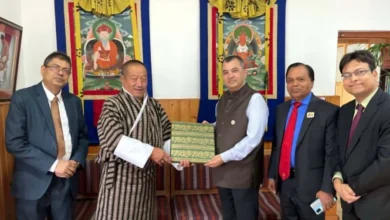JICA supports Bhutan disaster preparedness
The second joint coordination committee (JCC) meeting of the ongoing project “Capacity Enhancement of Meteorological Observation, Forecasting and Flood Warning,” was held on June 14.

Thimphu: In a concerted effort to bolster the country’s disaster preparedness and response capabilities, the National Centre for Hydrology and Meteorology (NCHM) has been collaborating with the Japan International Cooperation Agency (JICA) to develop advanced disaster warning systems and enhance meteorological accuracy.
The JICA Technical Cooperation Programme (TCP) aims to strengthen emergency response capabilities and foster the development of a resilient society in the Thimphu and Paro River Basins.
It focuses on enhancing NCHM’s observation and forecasting systems while effectively utilising data for efficient disaster management, including the establishment of a Flood Early Warning System (EWS) in the critical Thimphu and Paro river basins.
The second joint coordination committee (JCC) meeting of the ongoing project “Capacity Enhancement of Meteorological Observation, Forecasting and Flood Warning,” was held on June 14.
During the meeting, the Director of NCHM, Karma Dupchu stressed the role of quality data in forecasting and policy decisions, highlighting the significance of reliable data for the country’s preparedness and response strategies.
Karma Dupchu emphasised the importance of these basins. “In the south, we have major projects supported by these rivers for which a detailed study is a must.”
Chief Representative of JICA Bhutan Office, Tomoyuki Yamada said, “People should be aware of the data collected and have access to EWS.” He expressed his satisfaction with the progress made and emphasised the importance of effectively reaching the collected data to the people.
The Calibration Lab and Weather Studio were also inaugurated after the meeting.
Calibration Lab and Weather Studio are expected to contribute to Bhutan’s disaster preparedness efforts. The Calibration Lab will ensure the accurate calibration of weather observation instruments according to World Meteorological Organization (WMO) standards. Meanwhile, the Weather Studio will play a crucial role in disseminating extreme weather and flood forecast information to stakeholders and the general public.
As part of their plans, NCHM intends to install calibrated thermometers at 20 class-A stations across all dzongkhags, along with five snow stations dedicated to data collection.
The project is a collaborative effort between NCHM and several counterpart agencies, including the Department of Local Governance and Disaster Management (DLGDM) and Dzongkhag Disaster Management Officers (DDMOs) in Paro, Thimphu, and Thimphu Thromde, along with other collaborating agencies.
According to the NCHM report, Bhutan currently has a total of 234 stations, encompassing 59 hydrological stations, 155 meteorological stations for climate data, and 20 snow stations for cryosphere research.
The records maintained by NCHM highlight 61 instances of flash floods, heavy rainfall, flooding, glacial lake outburst floods, and stream catchment floods that occurred between 1968 and 2016.




